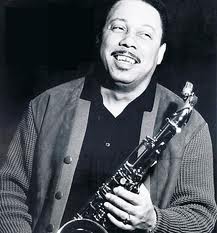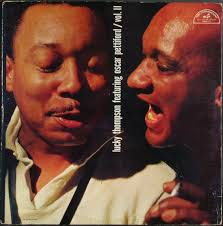Dancing Sunbeam – Eli "Lucky" Thompson
One of Lucky's better-known compositions, this medium swinger comes from the the classic Lucky Thompson/Oscar Pettiford trio recordings. Our quartet version has Minus You tracks for all instruments. The chord progression is related to the standard I Remember You, with several important differences.
- Recording: Lucky Thompson - Featuring Oscar Pettiford, Vol. 2
- Recorded on: December 11, 1956
- Label: ABC-Paramount (ABC 171)
- Concert Key: B-flat
- Vocal Range: , to
- Style: Swing (medium)
- Tenor Sax - Lucky Thompson
- Bass - Oscar Pettiford
- Guitar - Skeeter Best
Video
- Description
- Historical Notes
- Solos
- Piano Corner
- Bass Corner
- Drum Corner
- Guitar Corner
- Inside & Beyond
- Minus You
In this arrangement, the bass doubles the tenor sax melody on the A sections, walking on the bridge. The arrangement on our quartet version is taken from this recording, so the lead sheets are applicable for both versions. Lucky's short fill on the last chord of the ending is notated in the lead sheets.
The lead sheets shown here are identical to those shown under the Don Sickler Quartet album, above right; that album has Minus You audio tracks as well as a Piano/Drums part available.
Bassists, see notes under Bass Corner and the separate Bass part.
Vol. 1 and Vol. 2
Dancing Sunbeam is a really charming piece—fun to listen to and fun to play. Ranking at a 4.5-5 out of 10 for difficulty, it's also a good workout! The eight-measure intro has a slightly syncopated, modal feel that belies this lively and upbeat tune. As soon as you listen to it, you'll want to get on your bass and play along. The fingerings aren't very difficult—I played most of the upper register notes on the G-string and had no problem shifting back and forth to reach the notes in the lower octave.
It's a great piece to play along with the recording for bassists who are focusing on improvement, since Oscar Pettiford seamlessly switches back and forth between the melody line and walking. Pettiford's sense of time is immaculate on this album, and that's something every bassist wants: a strong enough pulse that no one misses the drums (and we don't on this track!). If you stay on your toes while playing along to make sure that you're locked into Pettiford and guitarist Skeeter Best, you'll learn how to both provide an unwavering pulse and play the melody.
Bassists should get the Bass part; it shows the melody and changes for the improvised sections.
Related Songs
Email Send Dancing Sunbeam to a friend
- Recording: Don Sickler - Don Sickler Quartet featuring Daryl Johns
- Recorded on: January 31, 2010
- Label: jazzleadsheets.com (JLS 1001)
- Concert Key: B-flat
- Vocal Range: , to
- Style: Swing (medium)
- Trumpet - Don Sickler
- Piano - Michael Cochrane
- Bass - Daryl Johns
- Guitar - Steve Johns
- Description
- Historical Notes
- Solos
- Piano Corner
- Bass Corner
- Drum Corner
- Guitar Corner
- Inside & Beyond
- Minus You
Note that the basic lead sheets are identical to the lead sheets available under the Thompson/Pettiford recording.
Trumpeter/arranger Don Sickler first met bassist Daryl Johns when Daryl competed in the Thelonious Monk International Bass Competition at the end of 2009. Don immediately envisioned Daryl playing Lucky Thompson compositions, and with the Thompson/Pettiford album in mind, Don organized the trip to the Van Gelder Studio that resulted in this recording.
Check out other tracks from this album.
As mentioned in the Bass Corner notes for the Oscar Pettiford/Lucky Thompson version, this piece requires the bassist to switch seamlessly between playing the melody and providing time.
CLIP Format of the recording:
-- intro
-- melody
-- piano solo 1 chorus
-- trumpet solo 1 chorus
-- bass solo 1 chorus
-- trumpet and drums trading 4s 1 chorus
-- out melody
There are two different Minus Melody tracks, a practice edition with the same format shown above plus a shorter performance edition. In the practice edition, the soloist has the opportunity to play accompanied by bass and drums only, as well as by piano and drums only. For more information about these two minus melody editions, check out our "Gigi Gryce Project" songs with a similar format such as Salute to Birdland.
There are two Minus You rhythm section parts: a separate bass part as well as a part that works for both piano and drums.
mp3 minus melody - get the lead sheet appropriate to your instrument (B♭ for trumpet and tenor sax, E♭ for alto sax, C treble clef or bass clef for piano, vibes, flute, etc.
practice edition (three solo choruses)
-- count off sets up the intro
-- play the intro and melody
three solo choruses
1 chorus with bass and drums
1 chorus with full rhythm section
1 chorus with piano and drums
-- trade 4s with drums [1 chorus]
-- play the out melody
performance edition: solo 1 chorus with full rhythm section
-- trade 4s with drums [1 chorus]
-- play the out melody
mp3 minus Piano - get the Piano and Drums part
-- count off sets up the intro
-- play figures and comp (where indicated) for the intro and melody
-- solo 1 chorus
-- comp for the trumpet solo and bass solo [1 chorus each]
-- comp for trumpet trading 4s with drums [1 chorus]
-- comp and play figures (where indicated) for the out melody
mp3 minus Bass - there is a separate Bass part
-- count off sets up the intro
-- play the intro and melody (walk on the B section)
-- walk for the piano solo and trumpet solo 1 chorus each
-- solo 1 chorus
-- walk for trumpet trading 4s with drums 1 chorus
-- play the out melody (walk on the B section)
mp3 minus Drums - Get the Piano and Drums part. On this recording, Steve Johns uses brushes throughout. Drummers playing with this recording can use sticks instead, or any combination of the two. Snaps have been added during the exchanges (trading) CLIP.
-- count off sets up the intro
-- play figures and comp (where indicated) for the intro and melody
-- comp for the piano, trumpet, and bass solos [1 chorus each]
-- trade 4s with trumpet (trumpet first) 1 chorus
-- comp and play figures (where indicated) for the out melody
Related Songs
Email Send Dancing Sunbeam to a friend

Eli "Lucky" Thompson
June 16, 1923 – July 30, 2005
Saxophonist Lucky Thompson is one of the great treasures of jazz. He was born in Columbia, South Carolina, but was raised in Detroit, Michigan. He played in local groups with Hank Jones, Sonny Stitt and others. In August, 1943, when he was 19, he left Detroit with Lionel Hampton's Orchestra, eventually arriving in New York City. Still a teenager, his first recording date was with Hot Lips Page on March 18, 1944. Later in 1944 he started recording with both Lucky Millinder and Count Basie. Read more...




